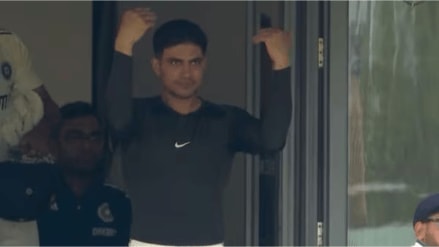India’s newly minted Test captain Shubman Gill may have delivered a career-defining performance at Edgbaston, but his declaration on Day 5 of the second Test against England did more than signal the end of India’s innings, it inadvertently ignited a commercial controversy that now threatens to cast a shadow over a marquee Rs 250 crore sponsorship deal.
As cameras panned to the Indian dressing room, Gill was seen instructing his batters to return from the field. Notably, he was wearing a black Nike vest, clearly visible and broadcast live. The gesture, meant to mark a commanding declaration at 427 for 6, quickly turned into a visual flashpoint, prompting questions about a possible breach of the Board of Control for Cricket in India’s (BCCI) apparel contract with Adidas. In any other setting, this might be a non-event. But in the hyper-regulated, big-money world of Indian cricket sponsorships, it landed like a bouncer.
Adidas, after all, is not just a logo on the Indian kit; it is the official apparel partner of the national team, men and women, across formats and age groups, under a deal reportedly worth Rs 250-300 crore from 2023 to 2028. The German brand pays for exclusivity: they manufacture all match-day, training, and travel kits and hold royal rights on visibility. A competing brand, and not just any brand but arch-rival Nike, being televised on India’s captain mid-match led to speculation about contractual non-compliance. However, it’s important to note that it is understood that Adidas, as per its agreement with the BCCI, supplies only official match, training, and travel kits, excluding personal base layers and undergarments.
Gill’s choice, spontaneous or not, sparked social media storms and whispers in legal departments. “Shubman Gill may have hit 500 runs on the pitch, but off it, he unknowingly triggered a brand visibility glitch, not with his bat, but his vest,” Nahush Gulawani, Co-founder at Wit & Chai Group, told financialexpress.com. “Adidas, the official sponsor, invested Rs 250 crore to secure front-row branding rights, only for Nike to grab headlines with a vest that wasn’t even in the script. That’s not ambush marketing, that’s ambient attention in action.”
Whether this was a case of careless layering or an endorsement hangover, the implications weren’t small. Gill is a Nike brand ambassador under what’s been described as a “multi-million-dollar” deal. His endorsement portfolio, already glittering with JBL, Gillette, CEAT, BharatPe, and Danone, is reportedly worth Rs 10-12 crore annually.
“Brand deals struck between brand owners and promoters of sporting events such as BCCI are really tight, tight collaborations,” Harish Bijoor, Founder, Harish Bijoor Consults Inc, explained. “In this case, I think Shubman Gill went a bit overboard wearing a Nike when BCCI is all about Adidas. To an extent, I do believe Shubman will be penalised for this and must be as well because brands have paid big monies to BCCI to be the soulless ones that will be spotted.”
There is precedent. Back in 2007, Sourav Ganguly was fined for donning a Puma headband when Nike was the official kit sponsor. A show-cause notice from the BCCI remains a likely next step, though neither the board nor Adidas has issued a formal statement yet.
“For Gill, this kind of conflict can blur his brand image in the short term, much like Ganguly’s Pepsi incident did years ago,” Hemal Majithia, Founder & Chief at Oktomind, said. “While strong performance and leadership can repair that over time, it’s a reminder that players need to balance personal deals carefully to maintain trust and alignment with team commitments.”
Gulawani was more pointed: “From a creative lens, this is the fine line where influence culture meets brand control. Today, visibility is no longer what brands dictate—it’s what audiences notice, share and create memes. And when an organic moment gets more buzz than a Rs 250 crore campaign, you know you’re in the age of accidental virality.”
Brand Gill may have had a bumper week on the pitch, breaking Sunil Gavaskar’s record for most runs in a Test and becoming only the third Indian captain to score centuries in both innings, but off it, his vest may have done what most marketing teams dream of: deliver explosive visibility with zero spend.
“If this were a campaign, Nike just pulled off the greatest unpaid collab of the season,” Gulawani quipped. “And Adidas? Well, they paid for a wedding and found out the groom wore someone else’s sherwani.” Whether Gill faces consequences or is let off with a warning, one thing is certain: in today’s fragmented media landscape, every visible inch matters. Even a loose thread in a cricketer’s wardrobe can unravel crores worth of corporate planning.
